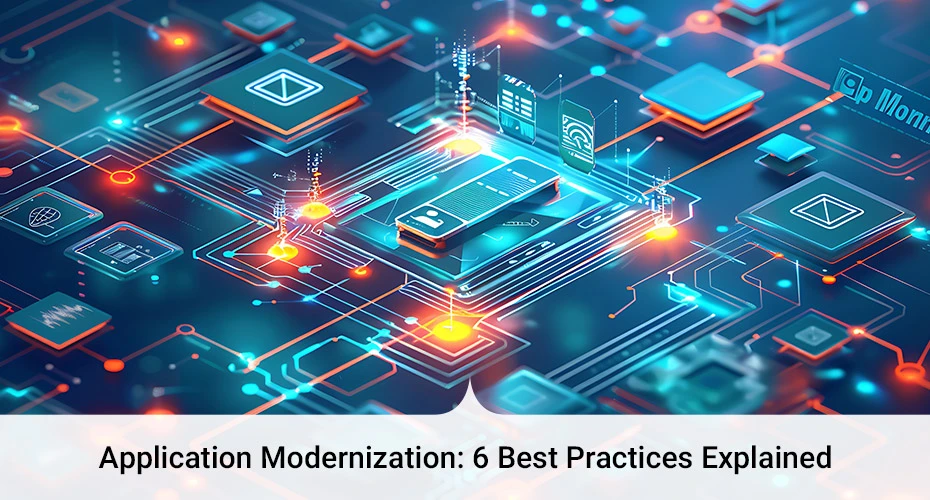

June 11, 2024 - by Synoptek
Today’s ever-changing business landscape compels organizations to constantly evolve to remain resilient and keep up with the pace of change. And though most organizations are quick to embrace modern technological innovations to drive better results, they often overlook the need to modernize and manage their applications to match the speed of current and future business needs.
Discover why modernization is critical to digital transformation and which application modernization best practices your organization needs to embrace.

Organizations across sectors are relentlessly attempting to migrate to the cloud. However, the presence of bulky, legacy enterprise systems makes the journey toward the cloud extremely challenging. These rigid systems lack the security needed to operate in today’s business world, and their absence of integration capabilities makes them an extreme misfit in a cloud-focused world.
However, lifting and shifting these rigid applications to the cloud is not an option. As the cloud opens doors to many new-age possibilities for businesses of all sizes, application modernization takes center stage. Application modernization allows your legacy systems to make the most of all that the cloud offers and helps them sustain the ever-growing and ever-changing requirements. It enables relevance and ensures your business’s long-term success.
Application modernization helps in:
The demands of today’s world necessitate modernized applications to operate seamlessly in a cloud-first world while meeting modern businesses’ reliability, security, scalability, and integration needs. While setting out on the application modernization journey, here are some best practices to follow:
The first step in the application modernization journey is to understand each application and its dependencies. Start by determining how each application performs in its current environment, operates under different conditions, and integrates with other systems in the ecosystem. Such understanding sets the stage for making informed, data-driven decisions and developing individual modernization roadmaps.
After a fair understanding of every application, you must weigh the tradeoffs. Identify applications that need to be modernized on priority, followed by those that can be modernized later. Simultaneously, identify and understand the risks associated with the modernization of each application and the approach that would best suit it. At the same time, evaluate the time and cost of each application modernization and quantify the benefits you expect to achieve in terms of better agility, scalability, reliability, or performance.
Modernizing applications requires a true organizational shift in mindset and new ways of thinking. Given that there are several ways in which applications can be modernized, you need to determine the modernization strategy that best fits the needs of your business. Based on how complex your legacy application is or the level of modernization you want to enable, you can either:
Modernizing legacy applications is not just about moving them to the cloud; it also requires you to plan to migrate the data they carry. Since most legacy applications have humongous amounts of data stored in them – most of which is too old or irrelevant for the modern world – it is crucial that you recognize what data is essential and needs to be moved. Document how data is represented in the old system, how it needs to be migrated, and what testing needs to be done to ensure the migrated data is accurate, relevant, consistent, and up-to-date.
The decision to modernize applications also brings substantial user antipathy that needs to be dealt with most appropriately. Since existing users are accustomed to operating legacy applications for day-to-day tasks, modernization would require them to leave their comfort zone and change their working methods. Therefore, before you begin the modernization process, it is critical that you communicate the need for modernizing the application, as well as the benefits users stand to accrue once the application is transformed. In addition, make sure to document all planned changes, as well as tips on how best to use the system for improved outcomes.
A significant issue with legacy applications is their relatively poor level of security, which, when not addressed, can lead to organization-wide security challenges. Therefore, embedding security at every stage of the modernization process is a core requirement that needs to be done diligently. Leverage best-of-breed security tools to carefully inspect the security challenges of your legacy systems and fix them as early as possible to safeguard your business from threats. Encrypt data whenever possible and implement robust access control and authorization measures to control access.
Given how quickly the business world is moving to the cloud, modernizing legacy applications is no longer a question of if but when. Since application modernization can help improve the security, reliability, efficiency, and relevance of critical business systems, embarking on the journey with thorough planning is extremely important, starting by understanding each application in detail and prioritizing applications that need to be modernized.
Next, each application’s modernization strategy should be determined, and a checklist for migrating data must be implemented. For organizational success, ensure that user concerns are addressed as soon as possible and that security is embedded into each process stage.
Ready to learn more? Discover how your organization can begin modernizing your applications.